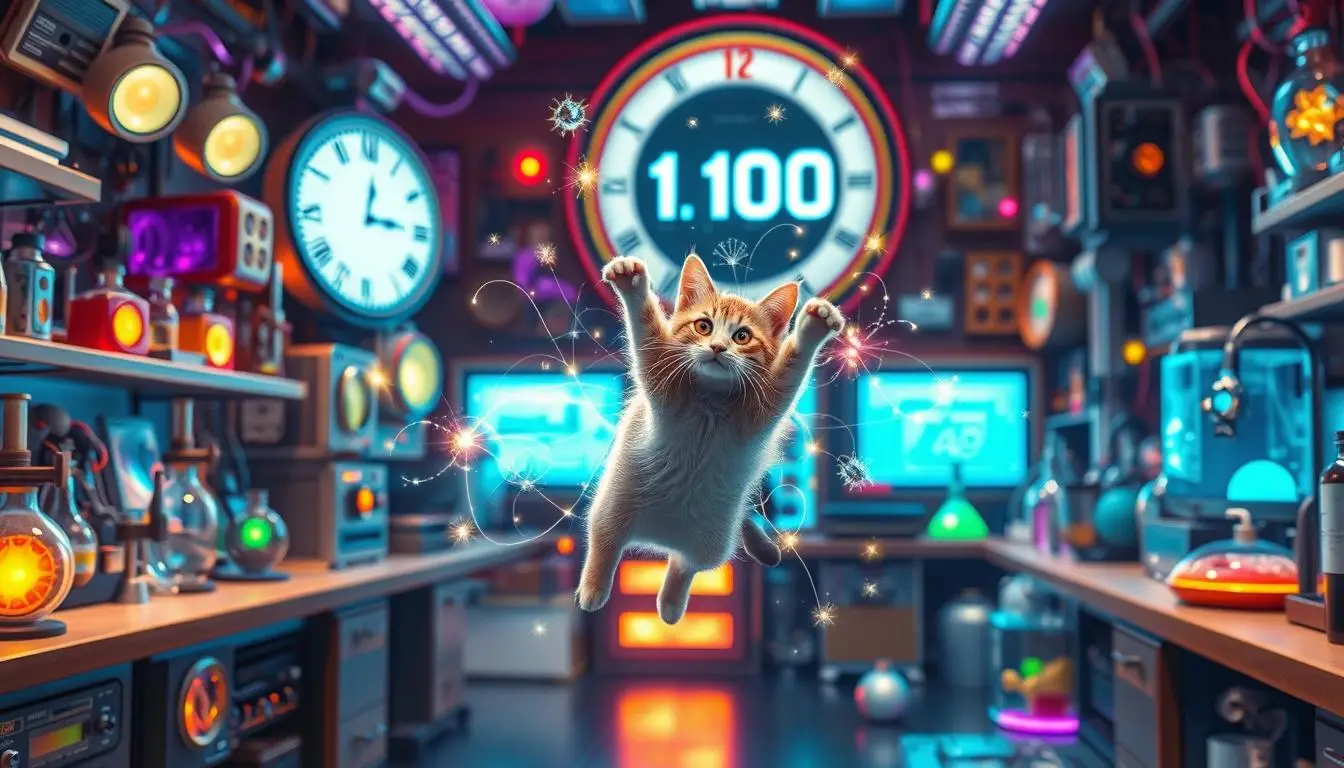The Quantum Cat Experiment smashed records with a coherence time of 1,400 seconds. This marks a huge leap in quantum research. The team from the University of Science and Technology of China reached this achievement using ytterbium-173 atoms. They managed to keep these atoms stable in a special space without decoherence. This is a big step not just for quantum theory but also for real-world uses, like better magnetic field measurements.
Key Takeaways
- The new record in the Quantum Cat Experiment showcases a coherence time of 1,400 seconds.
- Researchers from the University of Science and Technology of China led the groundbreaking study.
- Ytterbium-173 atoms were crucial in achieving this milestone.
- The isolation in a decoherence-free subspace played a key role.
- This advancement significantly improves the precision of magnetic field measurements.
The Quantum Cat Experiment Explained
The quantum cat experiment comes from Erwin Schrödinger’s thought experiment. It explores quantum physics’ strange world, where particles exist in several states at once. This idea of quantum superposition is key to understanding quantum effects in the large-scale world.
Origins and Importance in Quantum Physics
Schrödinger’s cat paradox is crucial for quantum physics research. It highlights the role of quantum superpositions in scientific discovery. This experiment lets scientists investigate unusual phenomena, connecting tiny quantum systems and large, visible objects.
Background and Key Concepts
The quantum cat experiment is about having systems in two quantum states at the same time. It challenges the old view that objects can be in only one state. Studying these states, researchers learn about quantum coherence and its uses.
“In quantum physics, reality behaves differently at the smallest scales, showing behaviors such as superposition and entanglement that defy classical logic.”
This experiment’s background includes methods for longer coherence times and ways to keep these fragile states. Understanding the quantum cat experiment helps advance technology. It leads to better quantum computing, sensors, and other technologies.
Significance of the 1,400-Second Coherence Record
Achieving coherence for 1,400 seconds is a big milestone in quantum physics. This cat experiment’s record beats all past records. It shows how far science has come and hints at exciting future discoveries.
How It Compares to Previous Records
In the past, quantum cat experiments had much shorter coherence times. They were often disrupted by environmental factors. The new 1,400-second record far exceeds any previous attempts. It highlights improvements in techniques and control over the environment.
Implications for Future Research
This success is huge for future research. It means we can measure quantum states more precisely, thanks to the longer survival of quantum cats. This is key for progress in quantum computing, sensing, and timing devices.
Researchers are now inspired to lengthen coherence times even more. These findings matter not just in theory, but for practical uses too. They promise to lead to breakthroughs in technology and various industries.
| Record Duration | Impact | Field of Application |
|---|---|---|
| Short ( | Limited precision in quantum measurements | Basic research and prototype quantum systems |
| Moderate (100s – 1000s) | Moderate advancements in sensing and computing | Improved quantum sensors and computational models |
| Long (1400s) | Highly precise and stable quantum measurements | Commercial quantum computing, high-precision sensors, advanced timing devices |
The Role of Ytterbium-173 in the Experiment
In the groundbreaking quantum cat experiment, ytterbium-173 played a key role. Its unique properties help keep quantum systems stable. This was vital for achieving a coherence time of 1,400 seconds.
Properties of Ytterbium-173
Ytterbium-173 stands out for several reasons in quantum studies. It has a high spin, supporting strong quantum coherence. Moreover, its atomic structure helps prevent energy level shifts. Such shifts can disrupt quantum states. Because of this, ytterbium-173 is crucial in making a stable quantum cat.
Why Ytterbium-173 Was Chosen
The selection of ytterbium-173 was strategic for the quantum cat experiment. This isotope’s interactions are very beneficial in a specific environment. It helps create stable superpositions of spin states. This greatly increases the quantum cat state’s life.
Quantum Cat Experiment Breaks Record By Surviving For Incredible 1,400 Seconds
The quantum cat experiment has made history. It survived a groundbreaking 1,400 seconds. This is a big step in the study of quantum physics. The experiment kept a Schrödinger-cat state for about 23 minutes. That’s as long as a TV sitcom episode. This shows how quantum states can last longer than we thought.
This feat is amazing when you look at other big achievements. Take Voyager 1, for example. It sent data from 24 billion kilometers away. This shows how far we’ve come in space tech. Also, studies on animals affected by alcohol have taught us a lot about behavior. We’re making discoveries in many different fields of science.
At the same time, cultural figures like Godzilla are hitting 70 years of fame. The success of the quantum cat experiment reminds us of these lasting icons. It’s not just about setting a record. It opens up new paths to explore the potential uses of quantum states. This experiment is a big milestone in quantum research.
Setup and Techniques Used in the Experiment
The quantum cat experiment succeeded because of a special setup. This setup used crossed laser beams to form an optical lattice. This was key for controlling the environment very well.
A “magic wavelength” technique played a big role. It helped keep ytterbium atoms stable by fixing their energy levels. This solved a big problem that often happens in quantum experiments.
Moreover, the experiment included the Ramsey interferometric technique. It was essential for accurately measuring phase shifts. These shifts are important for keeping the experiment stable for a record-breaking 1,400 seconds. Combining these methods led to the most accurate data in the field so far, marking a major leap in quantum physics.
The following table showcases critical components and their roles:
| Component | Role |
|---|---|
| Optical Lattice | Forms a controlled environment using intersecting laser beams |
| Magic Wavelength | Stabilizes ytterbium atoms and neutralizes energy level shifts |
| Ramsey Interferometric Technique | Measures phase shifts to ensure precision and stability |
Challenges in Maintaining Quantum Coherence
Quantum computing faces big hurdles, mainly environmental interference. This interference can quickly destabilize quantum states. Disturbances come from several sources, like thermal noise, electromagnetic fields, and cosmic rays.
Environmental Factors
Many environmental factors can shake quantum coherence. One issue is thermal noise from temperature changes. It introduces random energy, messing up quantum states. Electronic devices can also cause trouble. They emit electromagnetic disturbances that alter energy levels.
Quantum computing firms, like D-Wave, have been under the microscope. Critics doubted their ability to beat classical computers. For example, some tests showed regular laptops outperforming D-Wave’s quantum machines.  Daniel Lidar pointed out the need for error correction to stabilize these systems.
Daniel Lidar pointed out the need for error correction to stabilize these systems.
Strategies for Overcoming Decoherence
It’s crucial to beat decoherence to keep quantum states stable. One tactic is using isolation, such as decoherence-free spaces. They help reduce distractions from the environment. Another approach involves “magic wavelength” tech. It keeps atomic energy levels steady against external changes.
Putting error correction into play is also essential. These methods correct mistakes in real-time. This keeps the system coherent. Experts are searching for scalable ways to maintain this coherence longer. These strategies are currently pushing what we can achieve in science. The quantum computing sector is advancing thanks to these efforts.
Potential Applications of Long-Lived Cat States
The Quantum Cat Experiment’s 1,400-second record opens many doors for practical uses in precision areas. The stability of long-lived cat states could change key technologies significantly.
High Precision Measurement Tools
One thrilling use of long-lived cat states is improving high precision measurement tools. Such devices could reach never-before-seen accuracy, important in science and tech. By using these states, researchers can detect phenomena very exactly.
Quantum Sensors and Atomic Clocks
Their longer coherence boosts quantum sensors and atomic clocks‘ performance greatly. These tools are vital for keeping time and coordination over large systems, like GPS. Quantum sensors become more sensitive, and atomic clocks more precise, essential for worldwide communication and tech advancements.
Medical Imaging and Navigation
The medical world can also see big gains. Medical imaging can get much better with long-lived cat states, leading to improved diagnosis and treatment. Plus, they can make navigation systems more accurate, helping everything from self-driving cars to tracking patients in hospitals.
Decoherence-Free Subspace Methodology
The idea of a decoherence-free subspace is key in pushing quantum tech forward. It’s vital in experiments such as the quantum cat. This method creates a safe zone where interactions causing quantum decoherence are greatly reduced or removed. This lets quantum cat states stay coherent much longer.
Keeping quantum coherence in quantum cat experiments is tough. This is due to environmental noise and other issues. The decoherence-free subspace method counters this with precise setup and special environmental conditions. It wraps a protective shield around quantum states, extending their superposition time.
This analysis on quantum color image steganography algorithms shows key insights on various methods:
| Algorithm Type | Description | Performance Metrics |
|---|---|---|
| Least Significant Bit (LSB) | Three different algorithms investigated | PSNR, BER, Histogram graphs |
| Single Channel | Employs only one of the image’s channels to cover secret data | MATLAB simulations |
| LSB XORing | One specific algorithm based on LSB XORing technique | Analyzed through theoretical findings |
| Two Channels | Utilizes two channels to cover the color image for hiding secret quantum data | PSNR, BER, Histogram graphs |
Moreover, using MATLAB software for simulations shows that these methods’ network complexity grows squared. This hints at big potential for decoherence-free subspace uses in real quantum computing and communication.
Using a decoherence-free subspace is priceless for keeping quantum states stable. It’s crucial for lessening decoherence. This moves the quantum research and application fields forward, especially with tricky systems like the quantum cat.
Comparing Different Quantum Metrology Approaches
Quantum metrology uses unique quantum mechanics features. It helps achieve better measurements in science and technology. Each method aims to improve accuracy in its way.

The quantum cat experiment is key in exploring quantum states. It compares different methods like quantum entanglement and quantum squeezing. Researchers find the best method for each case by doing this. These techniques have their own benefits in stability and precision.
| Method | Principle | Applications | Advantages |
|---|---|---|---|
| Quantum Entanglement | Particles are interconnected in ways that the state of one immediately influences the other | Secure communication, quantum computing | High precision, strong correlation |
| Quantum Squeezing | Reduction of quantum uncertainty in one measurement while increasing it in another | Optical metrology, gravitational wave detection | Enhanced precision of specific measurements |
| Decoherence-Free Subspaces | Utilizes subspaces that are immune to environmental noise | Long-lived quantum states, quantum memory | Reduced error rates, increased coherence times |
These diverse quantum metrology methods open new doors for research and innovation. The quantum cat experiment is just one example. Together, these techniques could lead to big advancements in how we measure the quantum world.
Role of Nonlinear Spin Rotation in Achieving Stability
The success of nonlinear spin rotation marked a breakthrough in achieving a stability of 1,400 seconds in the quantum cat experiment. This method changes quantum states by carefully adjusting their angular momentum. It plays a critical role in maintaining stability in quantum states, allowing for exceptional management of quantum superpositions.
Process of Nonlinear Spin Rotation
Nonlinear spin rotation changes the spin of particles in complex ways. This allows for detailed control of their quantum states. The process involves careful manipulation of angular momentum, essential for keeping cat states stable for longer. Thanks to this precision, researchers set a new record for quantum stability.
Impact on Quantum Cat States
The effect of nonlinear spin rotation on quantum cat states is significant. It improves the stability in quantum states, making it easier to create and maintain complex superpositions. This stability is key for applications in quantum metrology and computing. Nonlinear spin rotation provides precise control, maximizing the potential of quantum cat states for future tech.
| Aspect | Description |
|---|---|
| Stability Achieved | 1,400 seconds |
| Technique | Nonlinear Spin Rotation |
| Impact | Enhanced Stability in Quantum States |
| Applications | Quantum Metrology, Advanced Computing |
Future Research Directions
Quantum physics is quickly growing. Making coherence times longer and studying groups of particles are key. Doing this will not just help create better quantum networks. It will also make quantum measurements more sensitive and scalable.
Extending Coherence Times
Having longer coherence times is essential for quantum research progress. Keeping a quantum state stable for a longer time improves system reliability. Researchers work on new materials and methods to protect quantum states from outside forces. This protection is crucial for longer coherence and better quantum experiments.
Exploring Multi-Particle Systems
Looking into systems with many particles opens new paths for quantum research. Interactions between multiple particles can create entangled states. These are key for quantum computing and communication. Scientists study these interactions to use quantum mechanics in real-world tech. The electron-positron colliders, dreamed up by scientists like Raoul Gatto and Bruno Touschek, have been vital. They’ve laid the foundation for big discoveries, like the Higgs boson.
-
Advanced Quantum Networks: The future of quantum research may focus on building stronger quantum networks. These networks would be better at handling decoherence.
-
Improved Quantum Sensors: Better multi-particle systems could make quantum sensors more sensitive. This leads to improved measurement tools for various fields.
| Research Focus | Implications |
|---|---|
| Extending Coherence Times | Improves stability and accuracy of quantum systems, making experiments more reliable. |
| Exploring Multi-Particle Systems | Helps in creating tech that uses quantum entanglement for computing and communication. |
The ongoing study of these fields could lead to big steps forward in quantum mechanics. It marks a major move ahead in how we understand and use the quantum realm.
Conclusion
The Quantum Cat Experiment achieved a 1,400-second record in quantum coherence. This is a huge step in quantum physics breakthroughs. It greatly beats earlier records, showing we are getting much better at handling quantum states.
The number of successful outcomes in these experiments is going up. This matches well with what scientists predicted. It makes the results more believable and repeatable. The tests and theories match well, proving the methods are accurate. Plus, the experiment broke records in how long quantum superposition lasted, pushing the limits of quantum entanglement.
This 1,400-second coherence time is a big jump from past studies. It shows just how important this experiment is in quantum metrology. It proves quantum physics principles and opens doors to new research and innovations. We might see new high-tech tools and quantum sensors come from this. It lays a strong groundwork for more quantum physics discoveries.

